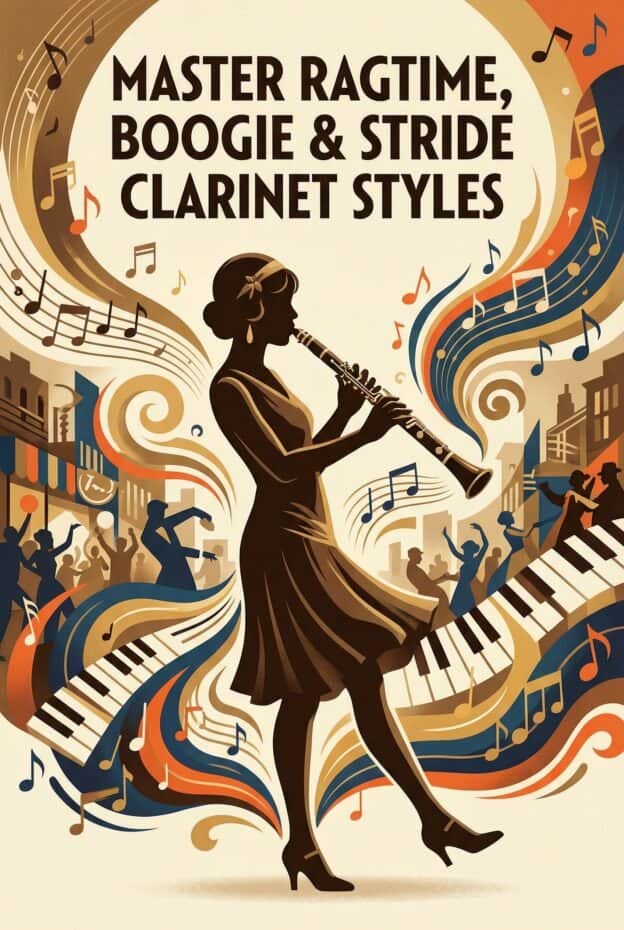The clarinet in ragtime, boogie-woogie and stride usually acts as a melodic lead or countermelody voice above the piano. To sound authentic, focus on clear articulation, a flexible but controlled embouchure, and confident register changes. Practice syncopated scales and broken chords with a metronome, and study recordings by Scott Joplin, Sidney Bechet, Louis Armstrong and James P. Johnson's “Carolina Shout” to shape your style.
Overview: Clarinet in Ragtime, Boogie-Woogie and Stride (late 19th-early 20th c.)
Ragtime, boogie-woogie and stride piano grew from African American communities between the 1890s and the 1930s. The piano usually carried harmony and rhythm, while the clarinet added a singing, vocal-like top line. Clarinetists learned to float over syncopated left-hand patterns, echo right-hand melodies, and weave countermelodies that danced around the beat.
Ragtime centered on written, syncopated piano pieces by composers like Scott Joplin. Boogie-woogie emphasized driving left-hand bass figures and blues harmony. Stride piano featured wide left-hand leaps and virtuosic right-hand lines, heard in James P. Johnson and Fats Waller. Clarinetists adapted to each style by shaping articulation, dynamics and register choices to complement the piano texture.
Across these styles, the clarinet bridged written and improvised traditions. Players borrowed from classical tone production but added jazz inflection, swing feel and flexible phrasing. Understanding this blend of discipline and freedom is key for modern students who want to sound authentic in ragtime and stride contexts.
Historical Context and Key Players (Scott Joplin, Sidney Bechet, Louis Armstrong, James P. Johnson, Fats Waller)
Ragtime blossomed in the late 19th century, with Scott Joplin's piano works like “The Entertainer” and “Maple Leaf Rag” becoming national hits. Although written for solo piano, these pieces inspired small ensembles where clarinet and cornet doubled or embellished the main melodies, especially in Midwestern and New Orleans bands.
Sidney Bechet and Louis Armstrong brought the clarinet and cornet into early jazz, which grew directly from ragtime and blues. Bechet's soprano saxophone style closely mirrors what a clarinetist can aim for: strong vibrato, clear projection and expressive bends. Armstrong's phrasing and rhythmic placement are important models for clarinet players learning to swing ragtime melodies.
James P. Johnson and Fats Waller defined stride piano in New York. Johnson's “Carolina Shout” and Waller's recordings such as “Handful of Keys” show how the piano can function as an entire rhythm section. Clarinetists who played with stride pianists learned to phrase like singers, leaving space around the left-hand bass and right-hand accents.
These musicians worked in theaters, dance halls and recording studios at a time when segregation limited opportunities. Their innovations in rhythm, harmony and phrasing shaped the clarinet's role in jazz. For students today, understanding this social and musical context deepens respect for the style and guides more sensitive performance choices.
How the Clarinet Functions Musically: Roles, Textures and Ensemble Interplay with Piano
In ragtime and early jazz, the clarinet often plays the lead melody, especially in ensemble versions of piano rags. It may state the main theme, then shift to countermelodies when cornet or voice takes over. The clarinet's agility makes it ideal for filling gaps between phrases and decorating the piano's written lines.
When working with boogie-woogie or stride piano, the clarinet usually sits above the texture. The left hand covers bass and chords, the right hand adds syncopated figures, and the clarinet weaves long phrases that cross bar lines. Think of the clarinet as a conversational partner: sometimes answering the piano, sometimes initiating new ideas.
Texturally, you will use three basic roles. First, unison or octave doubling of the piano's right-hand melody for strength. Second, offbeat stabs and short riffs that highlight syncopation. Third, flowing lines that connect chord tones and scale notes across several measures. Switching roles smoothly is a core skill for this repertoire.
Register choice is central to ensemble balance. The chalumeau register blends warmly with mid-range piano chords, while the clarion register can soar above stride figures without strain. The altissimo register should be used sparingly for climaxes, so the overall texture stays clear and not shrill.
Effective interplay also depends on listening. Track the left-hand bass pattern, notice where the right hand accents fall, and place your entries either slightly after the beat for a relaxed swing or directly on the beat for a more ragtime feel. This rhythmic awareness is as important as finger technique.
Core Techniques for Ragtime and Boogie-Woogie Clarinet (articulation, embouchure, register use)
Articulation in ragtime and boogie-woogie needs clarity without stiffness. Aim for a light, precise tongue stroke on the tip of the reed, using syllables like “tah” or “dah”. Short notes should be separated cleanly, but long notes can start with a gentle tongue and then connect smoothly to the next phrase.
Syncopated lines often combine slurs and tongued notes. A useful pattern is to tongue offbeat accents and slur through stepwise motion. Practice alternating measures of all-tongued sixteenth notes with measures that slur two or four notes at a time, so you can choose articulation patterns that match the piano's groove.
Embouchure must stay flexible but stable. Form a firm cushion with the lower lip, place the reed so that it vibrates freely, and keep corners gently in. Too much pressure will choke the reed and make high notes thin. Too little pressure will produce a fuzzy tone that cannot cut through stride piano.
The interaction of mouthpiece, reed and cylindrical bore shapes your sound. For ragtime and stride, many players prefer a medium-strength reed that allows quick response and easy bends without losing core tone. Experiment within a reasonable strength range to find a setup that supports both soft subtone and bright projection.
Register control is important. Practice moving between chalumeau and clarion on arpeggios built from ragtime chords, such as C, F and G7. Keep air support steady so that the break between A and B natural feels smooth. In boogie-woogie, you will often outline blues scales across the break, so evenness here is important.
Finally, add stylistic inflections such as gentle scoops into notes, narrow vibrato on sustained tones, and occasional grace notes. Use these sparingly so they enhance the line without turning into constant ornamentation. Listen closely to Sidney Bechet and early Louis Armstrong to model tasteful use of these effects.
Stride-Specific Approaches: Responding to the Left-Hand Bass and Right-Hand Melody
Stride piano features a powerful left-hand pattern that alternates bass notes and chords, often leaping an octave or more. As a clarinetist, your first task is to lock in with that left hand. Listen for the bass notes on beats 1 and 3, and feel how they anchor the time, even when the right hand becomes very busy.
When the pianist plays a strong right-hand melody, you can double it at the octave or harmonize in thirds and sixths. Keep your volume slightly under the piano when doubling, so the texture stays clear. When the right hand shifts to runs or fills, step forward with a clearer lead line that the audience can follow.
Call-and-response is a hallmark of stride settings. Agree with the pianist on short 2-bar or 4-bar exchanges. For example, let the piano play a rising figure, then answer with a descending clarinet phrase that uses the same rhythm but different notes. This conversational style reflects the improvisatory spirit of Harlem stride rooms.
Because stride bass is so active, you do not need to fill every space. Leave room on downbeats so the left hand can speak clearly. Aim to enter slightly after the bass note, placing your phrase on the “and” of 1 or 2 for a buoyant feel. This approach helps avoid rhythmic clutter and keeps the groove strong.
Register choices can highlight the stride texture. Try using chalumeau for earthy, bluesy responses to low bass figures, then jump to clarion for bright answers to right-hand runs. Practicing octave displacement of simple motifs will help you move between registers while staying rhythmically aligned with the piano.
Practice Routines and Exercises (scales, broken chords, metronome drills, finger-agility work)
A structured routine will help you translate classical technique into ragtime and stride fluency. Aim for 30 to 60 minutes per day, dividing your time between tone, finger work, articulation and repertoire. Keep a notebook to track tempos, keys and problem spots so you can measure progress over several weeks.
Start with scales in keys common to early jazz: B flat, E flat, F, C and G. Play them in straight eighth notes, then in swung eighths, at multiple tempos. Add broken chords outlining I, IV and V7 in each key. These patterns mirror the harmonic language of “The Entertainer” and many stride standards.
For syncopation, use a metronome and practice accenting offbeats. Set the metronome to click on beats 2 and 4, then play simple scale fragments that start on the “and” of 1 or 3. Gradually increase tempo while keeping articulation light and even. This drill trains your internal sense of swing and ragtime feel.
Finger agility work should target common ragtime figures, such as alternating thirds, chromatic neighbor tones and arpeggiated chords. Create 2-bar patterns that repeat across the instrument, then transpose them to several keys. Focus on relaxed hand position and minimal finger motion to maintain speed without tension.
Combine these elements in short etudes. Write or adapt 8-bar phrases that use broken chords, syncopated rhythms and register shifts. Practice them first slowly with a metronome, then along with recordings of ragtime or stride piano, matching articulation and dynamics as closely as possible.
For a 6-week plan, spend weeks 1-2 on scales and basic syncopation, weeks 3-4 on broken chords and register transitions, and weeks 5-6 on integrating these into repertoire and simple improvisation. Consistent, focused sessions will build the control needed for fast, clean ragtime lines.
Dynamics, Phrasing and Improvisation Strategies for Period Style
Dynamic control shapes the character of ragtime and stride clarinet playing. Use mezzo-forte as your default, with crescendos into phrase peaks and decrescendos at cadences. Avoid constant fortissimo, which can overpower the piano and flatten the music's expressive range.
Phrasing often follows 4-bar or 8-bar structures. Think in sentences: start with a clear idea, build tension through rising lines or rhythmic density, then resolve to a stable chord tone. Leave small breaths at phrase boundaries, even if you have enough air, to keep the musical grammar clear.
For improvisation in ragtime contexts, begin by varying written melodies. Change rhythms slightly, add passing tones between chord tones, or insert short pickups into the next phrase. This approach respects the original composition while giving you room to personalize the line.
In boogie-woogie and stride, blues language becomes more prominent. Practice major and minor blues scales in keys like C, F and B flat, and learn to resolve blue notes (flat third, flat fifth, flat seventh) to chord tones on strong beats. This tension and release is central to the style.
Period style often uses less chromaticism than later bebop. Focus on strong chord tones on beats 1 and 3, with passing tones and neighbor notes on weaker beats. Listen to early recordings by Louis Armstrong and Sidney Bechet to internalize how they balance simple, singable ideas with occasional bursts of virtuosity.
Finally, match your phrasing to the pianist's touch. If the piano plays crisp, detached ragtime figures, use slightly shorter notes and clearer articulation. If the pianist leans toward smoother stride, connect your notes more and use subtle vibrato. This sensitivity turns a collection of notes into a convincing historical style.
Recommended Recordings, Tunes and Listening Guide (“The Entertainer”, “Carolina Shout”, examples by Bechet & Armstrong)
Listening is important for learning any style, especially historically rooted ones. Start with Scott Joplin's “The Entertainer” and “Maple Leaf Rag” in solo piano versions. Even without clarinet, these recordings teach you how ragtime phrases breathe, where accents fall and how syncopation works against a steady bass.
Next, explore James P. Johnson's “Carolina Shout” and “Keep Off the Grass”. Notice how Johnson's left hand outlines stride patterns while the right hand spins melodies and runs. Imagine where a clarinet could double, answer or extend those lines, and then try playing along with selected sections.
For clarinet-like phrasing, Sidney Bechet's recordings such as “Si Tu Vois Ma Mere” and “Cake Walking Babies” are invaluable. Although he often plays soprano saxophone, his approach to vibrato, scoops and rhythmic placement transfers directly to clarinet. Focus on how he shapes long notes and attacks high pitches.
Louis Armstrong's early Hot Five and Hot Seven recordings, including “West End Blues” and “Potato Head Blues”, demonstrate melodic invention and rhythmic authority that every clarinetist should study. Transcribe short phrases and play them on clarinet, paying attention to articulation and swing feel.
For boogie-woogie context, listen to pianists like Meade Lux Lewis and Albert Ammons, then seek out small-group recordings where clarinet or saxophone joins the piano. Compare how the reed player adjusts volume, register and phrasing to sit comfortably above the driving left-hand bass.
Use reputable sources such as the Library of Congress and established discographies to find historically informed recordings. Reading liner notes and session details will also help you understand how these performances fit into the broader development of jazz and ragtime.
Common Problems and Troubleshooting for Tone & Articulation
Many players struggle with unclear articulation in fast ragtime passages. If notes blur together, slow the passage to half tempo and use exaggerated, light tongue strokes on each note. Keep the tongue close to the reed so motion is minimal, and avoid biting, which can stiffen the embouchure and hinder response.
Thin or weak high notes are another common issue, especially when playing above the break in clarion register. Check that your air support is steady and warm, as if blowing warm air onto a window. Relax the jaw slightly while maintaining firm corners, and experiment with small reed and mouthpiece angle adjustments to find a fuller resonance.
Register transitions can crack if finger coordination and voicing are not aligned. Practice slow slurred arpeggios across the break, focusing on moving fingers together and keeping the tongue relaxed. If notes still crack, review your throat position; think of saying “ee” for higher notes and “ah” for lower ones to guide internal shape.
Timing and syncopation problems often show up as rushing offbeats or dragging long notes. Work with a metronome set to click on beats 2 and 4, and clap or tap the basic rhythm before playing. Then add simple scale fragments on offbeats, making sure each note lines up consistently with the metronome clicks.
Finger tension can limit speed in broken chord patterns. Check your hand position: curved fingers, relaxed knuckles, and minimal lifting off the keys. Practice difficult passages as rhythmic variations, such as dotted rhythms and reversed dotted rhythms, to build control and evenness before returning to straight sixteenth notes.
Maintenance & Instrument Care (reeds, swabs, basic upkeep) – educational focus
Good maintenance supports reliable tone and articulation in any style, including ragtime and stride. Swab the bore carefully after each practice session to remove moisture that can swell pads and affect response. Avoid pulling the swab too forcefully near the upper joint, where tone holes and register key are more delicate.
Rotate several reeds rather than using one until it fails. Mark the date on each reed and switch daily so they wear evenly. Replace reeds that develop chips, cracks or dead response, since they can cause inconsistent attacks and unstable high notes, especially noticeable in fast ragtime figures.
Apply cork grease sparingly to tenon corks to ensure smooth assembly without forcing joints. Check that keys move freely; if you notice sluggish action or squeaks, a small amount of key oil at pivot points, applied by a technician or under guidance, can restore smooth motion.
Inspect pads regularly for discoloration, fraying or sticking. Sticky pads can cause sudden missed notes in rapid passages. Lightly cleaning tone holes with a soft cloth edge can help, but avoid aggressive scraping. For persistent issues, consult a qualified repair technician rather than attempting major adjustments yourself.
Store the clarinet in its case when not in use, away from extreme heat or humidity. Sudden temperature changes can affect the bore and tuning, making ensemble work with piano more difficult. Consistent care keeps your instrument responsive so you can focus on musical challenges instead of mechanical problems.
Teaching & Player Outcomes: Skills you should expect after focused study
With 6 to 12 weeks of focused work on ragtime, boogie-woogie and stride techniques, students can expect measurable improvements. Clean articulation at moderate to fast tempos, more secure register transitions, and better rhythmic accuracy with syncopated figures are realistic goals for dedicated practice.
Teachers can structure lessons around clear benchmarks: playing common ragtime scales and broken chords in several keys, performing short transcriptions of Bechet or Armstrong phrases, and accompanying a stride or ragtime pianist with stable tone and time. Regular recording and playback help students hear progress objectively.
Ensemble skills should grow as students learn to balance with piano, adjust dynamics in real time, and leave space for left-hand bass patterns. Trading 2-bar or 4-bar phrases with a pianist builds confidence in call-and-response and develops the ability to construct simple improvised answers to written themes.
Over time, students gain stylistic awareness: recognizing period-appropriate vibrato, articulation and ornamentation, and distinguishing ragtime feel from later swing or bebop. These outcomes not only enrich clarinet technique but also deepen understanding of early jazz history and its cultural roots.
For advancing players, a longer period of study can lead to more extended improvisations over ragtime and stride progressions, reliable performance of classic tunes at dance tempos, and readiness to participate in traditional jazz ensembles or historically informed school groups.
Further Reading, Archives and Resources
To deepen your understanding of ragtime and stride contexts, seek out historical studies on Scott Joplin, James P. Johnson and Fats Waller. Biographies and scholarly articles often include musical examples and analysis that clarify how piano textures evolved and how reed instruments interacted with them in bands and recording sessions.
Archives that preserve early sheet music and recordings, such as national libraries and university collections, are valuable resources. Original editions of rags like “The Entertainer” or early printings of “Carolina Shout” reveal phrasing marks, dynamics and arrangements that can inform your clarinet interpretations.
For clarinet-specific guidance, look for method books and articles that address early jazz and traditional styles, focusing on articulation, vibrato and ornamentation. Many educators publish transcriptions of Bechet and Armstrong solos adapted for clarinet, which serve as both technical studies and stylistic models.
Listening guides, discographies and annotated playlists can help you build a structured listening plan. Combining careful listening with score study and practical playing will give you a comprehensive view of how the clarinet fits into ragtime, boogie-woogie and stride traditions.
Key Takeaways
- The clarinet typically serves as melodic lead or countermelody above ragtime, boogie-woogie and stride piano, requiring clear articulation and confident register control.
- Focused practice on syncopated scales, broken chords and metronome drills builds the agility needed for fast, offbeat-heavy lines in common early jazz keys.
- Listening to Scott Joplin, Sidney Bechet, Louis Armstrong, James P. Johnson and Fats Waller provides important models for phrasing, dynamics and period-appropriate improvisation.
- Basic maintenance, including regular swabbing and reed rotation, supports consistent tone and response so stylistic work can progress smoothly.
FAQ
What is clarinet in ragtime?
Clarinet in ragtime refers to using the clarinet as a melodic and countermelodic voice alongside ragtime piano or small ensembles. The clarinet often doubles or decorates written ragtime themes, adding syncopated lines, clear articulation and period-style phrasing that complement the piano's steady, accented bass and offbeat chords.
How do I practice articulation for fast ragtime runs?
Start with short scale fragments at slow tempo, tonguing every note with a light “tah” or “dah” syllable. Gradually increase speed while keeping the tongue close to the reed and fingers relaxed. Alternate all-tongued patterns with slur-tongue combinations, and use a metronome to maintain even rhythm as you approach performance tempo.
What techniques help the clarinet blend with stride piano?
To blend with stride piano, match your dynamics to the pianist, use mostly clarion register for clarity, and leave space around strong left-hand bass notes. Shape phrases in 2-bar or 4-bar units, use clear but not harsh articulation, and adjust vibrato and note length to mirror the pianist's touch and rhythmic feel.
Which recordings should I study to learn authentic ragtime and stride clarinet style?
Study Scott Joplin's piano rags like “The Entertainer” for phrasing, James P. Johnson's “Carolina Shout” for stride texture, and early jazz recordings by Sidney Bechet and Louis Armstrong for melodic and rhythmic style. Transcribing short phrases from these recordings and playing along will help you absorb authentic articulation and swing.







